If you’re on this page, you probably already know what a pest fire ants can be. Along with causing a great deal of lawn damage, their sting is extremely painful. The good news is if you take the right steps, getting rid of fire ants is a rather simple process. Stick around and we’ll show you how to get rid of fire ants with proven fire ant control techniques.
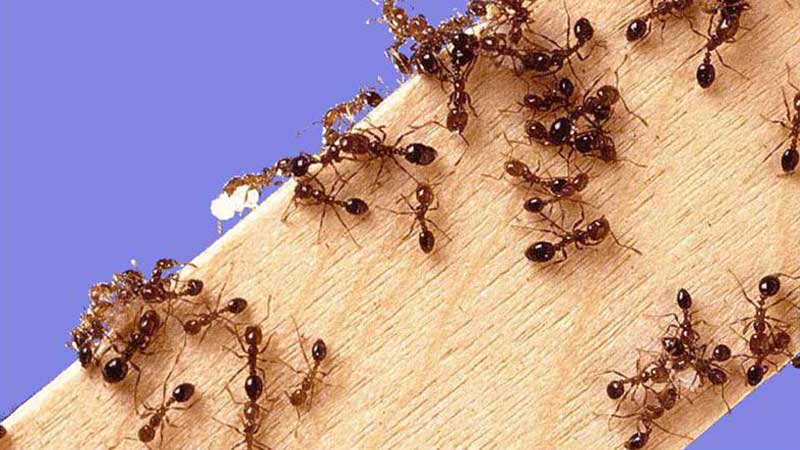
Unlike other ant species, fire ants typically do not invade your home, but when you have several mounds of fire ants in your yard, it could become a concern for children, pets, and your own personal sanity.
While other species are seen as simple pests, fire ant stings (yes, they do sting) can lead to swelling, difficulty breathing, and a number of other health complications — even death in some highly allergic individuals. In this article, we will explore fire ants’ behavior, habitat, and possibly the main reason you’re reading this article – how to get rid of fire ants.
List of the Best Ways to Kill Fire Ants
While fire ants typically aren’t a nuisance in your home, outdoor spaces are a whole other matter. When pets or humans come into contact with fire ants, a number of painful encounters can ensue, leading many to ask the question, “What’s the best way to kill fire ants?”
As mentioned previously, fire ants can be highly aggressive, so a direct confrontation with fire ants (such as swinging a bat at the mound) is hardly effective, and fire ants will use their numbers against you. The sheer numbers of fire ants and their speed can make fire ant stings quite painful. When stung, people often experience a range of reactions, including pain, nausea, skin irritation, and even difficulty breathing in some instances.
Once fire ants have set up a sizable colony, complete extermination can prove to be quite difficult. Therefore, we recommend a treatment and prevention approach in order to resolve the current fire ant problem and keep it from happening again in the future. First, let’s explore some of the best ways to neutralize fire ants if you should find a mound or colony on your property.
1. Ortho Fire Ant Killer Mound Treatment
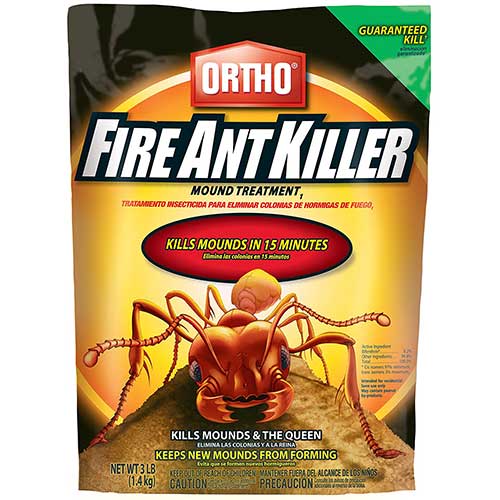
Ortho Fire Ant Killer mound treatment is an effective way to kill ants in individual mounds. This product is applied to the mound and in a 3-foot diameter around the mound. The area is then drenched in water to have the product penetrate deep into the ground. This can kill the ant colony and the queen. This is typically the first step to get rid of fire ants. A broadcast treatment can then be used to help ensure surviving fire ants or new fire ants do not come into the area.
If homes in the area use well water this may not be a good option to use. This is because the chemical may eventually reach your drinking water.
2. Ortho Fire Ant Killer Broadcast Granules
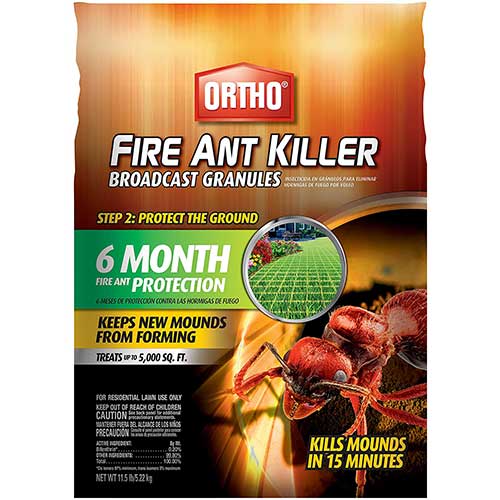
Ortho Fire Ant Killer Broadcast Granules is used to prevent fire ants from coming to an area. This is typically applied once the individual mounds have been treated. It can also be used in areas that are prone to having fire ant problems to solve the problem before there is one.
To get the most out of broadcast bait, it should be spread several times during the warmer months. Since fire ants are more active during the rainy seasons of spring and fall, you will want to target your treatments during these times of the year. This method is 85% effective in controlling fire ant populations. If there are any mounds leftover on the property after applying the broadcast bait, you can treat these with bait on a case-by-case basis.
The bait method will take time before you start to have noticeable results. But, the success rate of this method is right around 85%, making it one of the best options currently available to homeowners.
The active ingredient in fire ant bait, hydramethylnon, is safe to apply on lawns frequented by children and pets. But, if you have a well-based water drinking system, you may want to consider a more natural approach to fire ant control.
3. Go Organic with the Diatomaceous Earth Treatment

Organic Diatomaceous Earth is a way to kill fire ants with the fossilized remains of phytoplankton! This is a safe way to treat fire ant mounds. This powdery substance contains the fossils of diatomic sea creatures from the age of the dinosaurs. How it works is pretty remarkable. In a treated mound, the ants will collect the diatomaceous earth powder on their exoskeletons, which not only dries out the ants, effectively turning them to ant jerky and killing them, but the jagged particles also slice through the tough layers of their exoskeleton.
Using diatomaceous earth to kill fire ants is generally considered the best method if the health of children, pets, lawns, and the environment is a concern.
4. Terro Liquid Ant Baits To Kill Fire Ants Inside
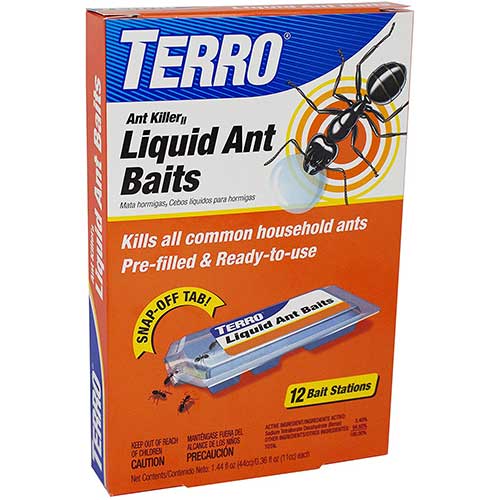
Terro Liquid Ant Baits of one the most popular ant treatments on the market today. The ants come to eat the scented sugary bait which is food. The borax in the bait is what kills the ants. This does not happen immediately though. Foraging ants bring the bait back to the nest so other ants in the colony can eat. The bait will kill the ants you see at the bait and other ants in the colony that you do not see but are living somewhere in your house. It may take up to two weeks to kill all the ants depending on the size of the ant problem. This method is primarily used inside but could also be used in the garage, shed, or outside.
5. Get to the Queen by Using the Rod Method
As we’ve said before, to really prevent the colony from relocating to another spot and creating more six-legged micro-demons, you really want to go after the queen. One of the best ways to do this is by using something known as the “rod method.” To perform the rod method, press a number of narrow tubes into the center of the mound. Next, pour insecticide into the tubes. This method is very effective at eliminating the queen and preventing the colony from re-establishing in another location on your property.
Treating Individual Mounds, is it Worth the Effort?
If you haven’t applied a treatment using the broadcast method, going after each individual mound can be a huge pain and a rather ineffective way of treating your fire ant problem. Treating individual mounds also gives the fire ants time to simply relocate to a more hospitable location on your property, thereby only buying you a little time until the next mound (or several mounds) pops up.
But, if you do choose to go this route, trying using a general insecticide in liquid form. Be sure to saturate the mound completely. Fire ant queens are usually situated fairly deep inside of the mound, making it difficult (not impossible) to kill these egg-laying machines. Be sure to apply bait around the mound’s perimeter to target ants looking to relocate.
6. Pour Boiling Water on the Mound
Whether you’re a traditionalist or just looking to avoid the use of chemicals on your lawn, you can try to pour some boiling water onto the mound as well as the perimeter of the mound. So, what are some of the drawbacks of using this folksy approach? It’s barely effective; 40% of the time, the queen will survive and simply go about building up the population of her colony again. Plus, there is a good chance the boiling water will kill nearby grass and other vegetation. Worse yet, you could accidentally splash scalding water on yourself while transporting the pot across your lawn.
7. Pest Control Experts Way to Kill Fire Ants
Not all pest control experts agree on one method of killing fire ants, but most have come to the conclusion that a two-step process works best. This two-step process involves applying a broadcast bait across the property (and reapplied every month or two during spring, summer). This should then be followed by going after the mounds individually, applying either a mound drench solution or a similar pesticide.
If you are not having any luck with store-bought fire ant control products, you may want to enlist the help of a licensed pest control professional, who often have access to more powerful pesticides as well as training on their proper use.
Mound-Drenching Treatments for Fire Ants
This is similar in approach to individually treating each mound with an insecticide, but will be more effective if you go with a pesticide specifically formulated for fire ants. With mound drench products, enough of the liquid should be used to saturate the mound as well as any areas below the surface of the mound. With this method, you can expect to kill a majority of the ants within an hour or two. But, if you are on a well-based water system, you may want to do your research first to see if this type of product is safe to use.
Related Article: 8 Best Ant Killer Products
How to Prevent Fire Ant Infestations
If you’ve previously had fire ants on your property, you are likely wanting to know some effective ways to keep the little buggers in check.
A few simple things you can do to prevent fire ants from establishing a colony on your property include:
- Keep pet food indoors — While fire ants typically will not go indoors in search of food, they will make use of any food that is easily accessible to them, such as pet food. If you’ve had recurrent problems with fire ants on your property (or just looking to prevent an infestation), limiting the amount of available food will help prevent future occurrences.
- Improve soil drainage — Fire ants love soil with high moisture content. If you notice areas of your yard that are slow to drain after heavy rainfall, you may want to look into improving your soil’s drainage.
- Preventative broadcast baiting — One of the most effective ways to prevent fire ants from establishing a colony on your property is to treat your lawn so that any potential worker ants or queens will be killed before they ever have a chance to build a mound. Remember: a queen fire ant can lay over a thousand eggs per day, making this pest incredibly hard to eliminate once they’ve established a sizable population. Most professionals recommend treating the lawn every month or two to ensure fire ants are kept at bay.
- Keep logs and branches off the ground — Waterlogged branches and logs are popular breeding grounds for fire ants, so removing these from the property should be a priority. Be sure to wear long gloves when attempting to remove any downed tree limbs from your probably, as there may already be a fire ant presence.
How Can I Tell If I Have Fire Ants?
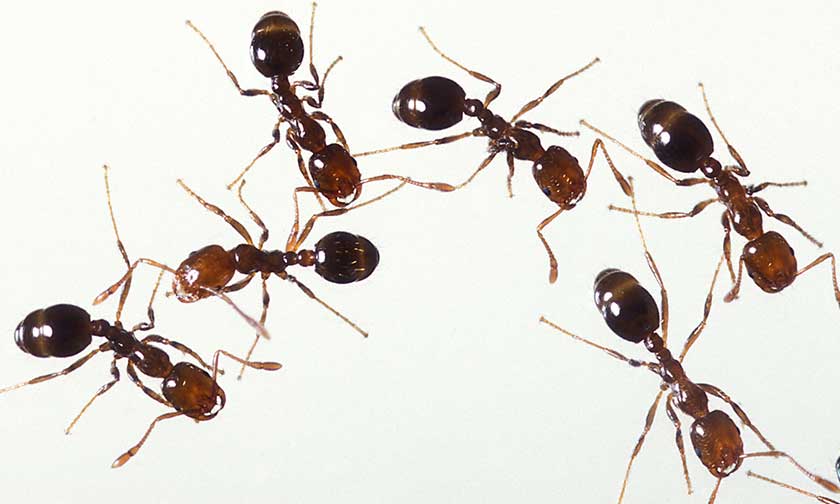
So, how can you tell if you have a red imported fire ant problem on your property? The most obvious sign will be a large, 12-18″ mound of loose dirt on your lawn. Unlike other species of ant, red imported fire ant mounds do not have a center opening at the top of the mound. And, depending on the climate of where you live and the property’s soil type, the fire ants may not actually build a mound, but choose to build their colonies below ground.
There are several varieties of fire ants with the most intrusive being the “red imported fire ant” (Solenopsis invicta). Native to South America, red imported fire ants were accidentally introduced to the United States, Caribbean nations, Australia, and New Zealand some time starting in the 1930’s.
What Do Fire Ants Look Like?
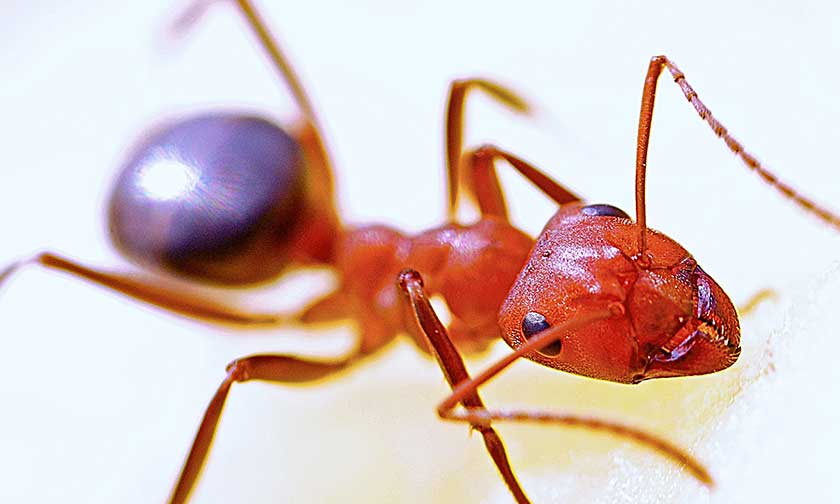
Harvester ants, being a rusty, brownish color are often mistaken for fire ants. One other species of ant that is commonly misidentified as a fire ant are known as “cow killers” or “velvet ants,” but these are actually a true wasp. The males within this species have wings, but the females are wingless.
Fire ants can be identified apart from other ants by their dark shade of abdomen and a head that is a reddish, copper color. Most likely, the type of fire ants you will encounter in your yard or garden will be the worker ants. Workers are of a darkish red color and range in size from .07” to .23” (2 to 6 mm). If you happen to find a nest by digging a hole into the soil, or by breaking open a rotted log, you will most likely find a variety of fire ants, including winged male and female ants, as well as one or several queens.
Spotting the queen can also be difficult, as she sheds her wings after the first time she mates and establishes a colony. She will be visibly larger than the other fire ants, but in a sea of fire ants, looking for the largest is often quite difficult.
Within a red imported fire ant colony, there will be a queen, workers, and soldiers. A single queen can produce over a million eggs throughout her six-year lifespan, averaging 1,500 to 1,700 eggs per day.
Types of Fire Ants
Fire ants are just one of the hundreds of species of ants that compose the genus Solenopsis. Thankfully, only a few ants within this genus are known to sting. These include “ginger ants,” “tropical fire ants,” and the notorious “red imported fire ant.”
Red imported fire ants, in terms of stinging ability, are second only to the “Bullet Ant” (P. clavata), a member of the Paraponera genus, which is only found in the rainforests of Paraguay, Honduras, and Nicaragua… for now.
Behavior and Habitat
Fortunately for us, fire ants tend to stay outdoors where they make nests in damp soil and other wet-prone environments, such as near creeks, streams, and along riverbanks. Do you regularly water your lawn? If you answered to the affirmative, you may actually be creating the perfect environment for your opposition. Like you, fire ants love lush, green lawns. Fire ants also love open areas where they can get plenty of sunshine, making landscaped areas, mulch beds, lawns, and parks popular breeding grounds. Fire ants also construct vast networks of tunnels below ground, especially near your home’s foundation.
Frequently Asked Fire Ant Questions
Do fire ants sting or bite?
Both, actually. In all likelihood, it’s not the bite that you feel, but the sting; fire ants typically only use their mandibles as a way to get a grip so they can inject their victim with their stinger.
As part of the same family that became wasps, a fire ant’s sting can pack a mighty punch. When you are stung by a fire ant, the venom will create a hot, burning feeling that is sometimes accompanied by itching, swelling, and pus-filled blisters around the site of the sting.
Fire ant venom is mostly composed of piperidine, a type of oily alkaloid. This is mixed with several proteins that are toxic to its prey, as well as unsuspecting humans and pets.
How Do Fire Ant Baits Work?
Fire ant baits have an active pesticide ingredient (commonly hydramethylnon) as well as some type of starchy grits such as finely ground cornmeal. The workers within a fire ant colony will take the poisoned bait back to the colony to be served to the queen and other ants.
Due to her size, the queen may not be killed by the poisoned bait, but it will at least render her infertile and unable to reproduce. But, the vast majority of the worker and soldier ants will be killed.
Are fire ants dangerous to humans?
Typically, fire ants are more of a nuisance than a danger to humans. Fire ants, and especially the red imported fire ant, will fiercely defend their colonies by stinging any threatening creature (no matter its size). Although, those allergic to fire ant venom may experience difficulty breathing and swelling around the throat. If you experience either of these symptoms following a sting, consult a medical professional as soon as possible.
Treating a fire ant sting
If you have been stung by a fire ant, there are some types of medications and topical treatments that can help with the side effects. Some popular topical home remedies include dabbing the area with a diluted bleach solution, then applying aloe vera to the affected area. To help to prevent the itching sensation that comes with a fire ant sting, you can take an antihistamine.
As mentioned previously, if you are short on breath, have swelling, profuse sweat, or other serious side effects, seek the help of a medical professional as soon as possible.
Why do I have fire ants in my yard?
If you have fire ants in your yard, it’s likely that they’ve come to share your property because they liked the soil content and food sources. Fire ants love damp soils, rotting vegetation, as well as wide-open spaces where they can forage for food. But, red imported fire ants can also appear in your yard due to eggs in mulch or sod.
Why you shouldn’t attack a fire ant mound?
If you find a fire ant mound in your yard, your first instinct may be to beat it down with a rake or shovel. This would be a huge mistake. Red imported fire ants are hyper-aggressive and they will swarm-attack in reaction to even the slightest disturbance to their mounds — especially if their egg sacs are disturbed. They may be small, but fire ants are fierce and they will go to any length to protect their nest
So, how do you go about banishing red imported fire ants from your property? The smart way, of course. But, before we get into the many creative ways you can kill fire ants, let’s take a moment to be philosophical, sensible, and ask if there are any benefits to having fire ants on your property.
Can fire ants be beneficial?
All types of ants – fire ants included — help to aerate the soil and decrease the amount of soil compaction, making the soil healthier. Plus, as omnivores, fire ants will feast on other less-desirable pests, such as flea larvae, mites, ticks, chiggers, and flea larvae.
Many farmers appreciate having fire ants on their property as they not only aerate the soil but also help to reduce the number of crop-jeopardizing pests, namely caterpillars and boll weevils.
If you’re not a farmer and you’re anxious to reclaim your property from these little red devils, let’s dive into the best ways to kill fire ants. #killfireants
Your pets and fire ants
Dogs and cats are curious creatures. If they find a new mound on your property that wasn’t there before, they may sniff around to see what it’s all about. Pets may accidentally disturb the mound, fire ants can quickly begin their swarm-and-attack behavior, quickly stinging your pet on the portions of their body where there is relatively little fur, such as the belly, mouth, ears, and eyes.
If you find fire ants on your pet, your first reaction will likely turn to spray them off with a garden hose. Don’t. Spraying fire ants with a hose will only make them agitated and cause the fire ants to sting your pet repeatedly. Instead, you should try to remove the fire ants using tweezers or seek out the assistance of a veterinarian. If your pet is very young, small, in a weakened state due to age or other health issues, you may want to watch over them following a fire ant sting and take the pet to a veterinarian if you notice any changes in their behavior.
Related Article: How to Keep ants of Humming Bird Feeders
What about fire ants in the home?
Although indoor fire ant issues aren’t as common as fire ants building mounds outdoors, fire ants have been known to seek out moisture-rich, dirt crawlspaces, as well as other spaces with easy access through your home’s foundation
To keep fire ants from making a home of your home, you can apply pyrethroid or chlorpyrifos insecticide around your home’s foundation. Be sure to seal up any crevices or any cracks in your home’s foundation as these are popular points of entry with fire ants.
If you notice fire ants within your home, try using a fire ant bait that contains hydramethylnon, sulfuramid, or abamectin. These should be placed in areas that are out of reach of curious children and pets.
Closing Thoughts About Fire Ants
Fire ants may be a pain (quite literally sometimes), but that doesn’t mean they can’t be defeated. If one method of fire ant control doesn’t work, move onto the next until you find a solution that works for your particular property type and species of fire ant. If after trying several different remedies you may want to enlist the help of a licensed pest control company. Best of luck in your fire ant-eliminating endeavors!
My name is Blane and I’m a life-long resident of Southeastern Louisiana. I’ve been working as Pest Control Technician and Inspector for about 1.5 years now.
I’ve worked in many other industries as well, including consulting, managing, as well as at the ground level in fields including Food Service, Corporate Automotive sales, and finance. Whether it be providing counsel, content, or hands-on support; my goal remains to add value to the lives of the people I serve.
If you have any questions regarding pest control, leave them below. I would be happy to help you out in any way I can.

I have had some success using a mixture of table sugar and borax (1 to 1 ratio mix, e.g. 1 cup of each) with a handful or 2 of raw uncooked dry (old fashioned) grits and I add a dab of protein power. I place the mixture (1/4 cup or so in a plastic container with a lid and openings that allow ants to get to the bait. It may take up to a week before all ants are gone. After a few days, I find only a few ants active in the mound.
I can then move the remaining bait to another mound when I find no ants in the mound.I am in Southeast Louisiana.
I live in a rural area of Fort Worth, Texas right next to a small cattle ranch. I have red ants which Amdro seems to take care of but I have what seems to be black fire ants too! They are all black, have red fire ant-like mounds, swarm-like red fire ants, and sting like red fire ants, but they’re 100 percent all black!
I’ve tried Amdro on these mounds, but it seems to be little to no help!
I’m going to home depot later today and get some orthane to mix with water and pour into the mounds.
I’ve never heard of Black fire ants before and the regular fire ants here are red and black. Did some red fire ant mate with a black ant and create a genetically different colored ant?
I would like to know more about these ants that seem to not be affected by Amdro!
Thank you in advance.
Thanks so much for the article. I live in SW Louisiana and fight fire ants year round on the prairie. I was bitten at 17 months old and rushed to the hospital with convulsions and almost died. I’m 59 now and even one bite can be horrible. A solution of 1 tsp bleach and 1 tsp water applied within 15 minutes of the bite has prevented itching and permanent scarring on my thin skin. I hope this can help someone else like me.
I have fire ants all along the walk in my front yard and if I try to sweep the walk the cover my feet with bites that just keep stinging. What can I use to kill them and not hurt my dog? Their bites leave my feet stinging for an hour or two. What will get rid of them for good?
I am glad I came across this article. Ants are really dangerous, and I need to protect my family from them.